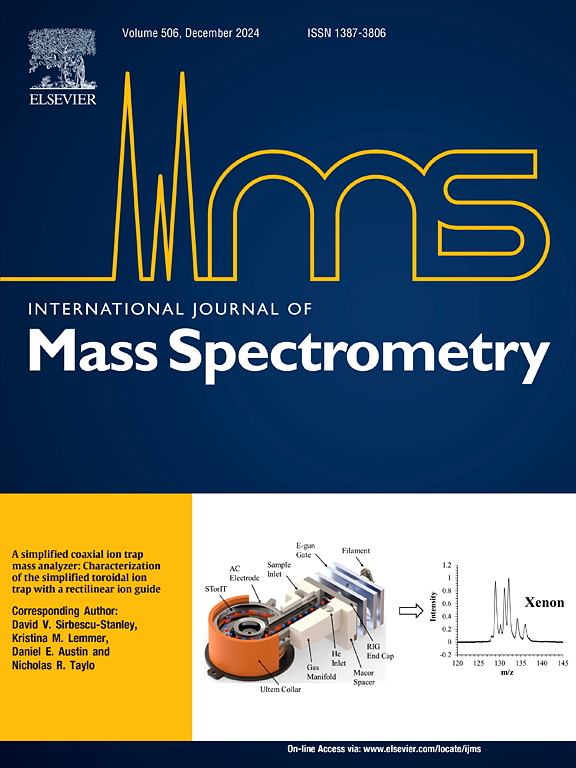Two-dimensional tandem mass spectrometry in a linear quadrupole ion trap using consecutive product ion sweeps
IF 1.7
3区 化学
Q3 PHYSICS, ATOMIC, MOLECULAR & CHEMICAL
引用次数: 0
Abstract
Two-dimensional tandem mass spectrometry (2D-MS/MS) is a powerful analysis technique which can quickly produce a map of all precursor-product ion relationships within a sample, from a single ion injection event, and is greatly suited to low-cost instrumentation like ion traps. The ability to record this type of information in an unsupervised and unbiased manner makes this technique highly amenable to artificial intelligence-based workflows which can statistically examine the datasets to perform structural elucidation, generate more confident peak assignments, and/or discover new chemistries. Previous implementations of the 2D-MS/MS scan function kept the RF voltage applied to the trap constant and scanned an auxiliary frequency to eject and detect the product ions. A direct consequence of this is that ions of higher precursor and product m/z would have a lower observed mass resolution and sensitivity, leading to more potential candidates for peak identification algorithms and higher uncertainty in the reported results. Herein, we describe a new approach to 2D-MS/MS analysis in a linear quadrupole ion trap which utilizes consecutive, traditional, RF amplitude ramps to resonantly eject ions from the trap near the boundary of the Mathieu stability diagram. Relative to its predecessors, the technique does require more time to acquire, however, it necessitates fewer instrument modifications and has more robust calibration procedures. More importantly though, its use produces higher sensitivity spectra with constant 2D peak resolutions (3 Da FWHM @ 125 kDa/s), which can be predicted based on the set product ion scan rate and resonant ejection point. Additional discussion is aimed at methods by which the scan might be improved, or optimized, for higher speed workflows utilizing sample arrays. This work paves the path towards isotopically resolved 2D-MS/MS spectra, which would greatly enhance the power of the technique.

二维串联质谱法在线性四极离子阱使用连续产品离子扫描
二维串联质谱(2D-MS/MS)是一种功能强大的分析技术,可以从单个离子注入事件中快速生成样品中所有前体-产物离子关系图,非常适合离子阱等低成本仪器。以无监督和无偏见的方式记录这类信息的能力使该技术高度适用于基于人工智能的工作流程,可以对数据集进行统计检查,以执行结构解析,生成更自信的峰值分配,和/或发现新的化学物质。以前实现的2D-MS/MS扫描功能保持施加于陷阱的射频电压恒定,并扫描辅助频率以弹出和检测产物离子。这样做的一个直接后果是,前驱体和产物m/z较高的离子将具有较低的观察质量分辨率和灵敏度,从而导致更多的潜在候选峰识别算法和报告结果的更高不确定性。在此,我们描述了一种在线性四极离子阱中进行2D-MS/MS分析的新方法,该方法利用连续的传统RF振幅坡道从Mathieu稳定性图边界附近的阱中共振地射出离子。相对于其前身,该技术确实需要更多的时间来获得,但是,它需要更少的仪器修改和更稳健的校准程序。更重要的是,它的使用产生了更高的灵敏度光谱,具有恒定的二维峰值分辨率(3 Da FWHM @ 125 kDa/s),可以根据设定的产物离子扫描速率和谐振弹射点进行预测。另外的讨论是针对方法的扫描可能被改进,或优化,为更高的速度工作流程利用样本阵列。这项工作为同位素解析2D-MS/MS光谱铺平了道路,这将大大提高该技术的能力。
本文章由计算机程序翻译,如有差异,请以英文原文为准。
求助全文
约1分钟内获得全文
求助全文
来源期刊
CiteScore
3.60
自引率
5.60%
发文量
145
审稿时长
71 days
期刊介绍:
The journal invites papers that advance the field of mass spectrometry by exploring fundamental aspects of ion processes using both the experimental and theoretical approaches, developing new instrumentation and experimental strategies for chemical analysis using mass spectrometry, developing new computational strategies for data interpretation and integration, reporting new applications of mass spectrometry and hyphenated techniques in biology, chemistry, geology, and physics.
Papers, in which standard mass spectrometry techniques are used for analysis will not be considered.
IJMS publishes full-length articles, short communications, reviews, and feature articles including young scientist features.

 求助内容:
求助内容: 应助结果提醒方式:
应助结果提醒方式:


